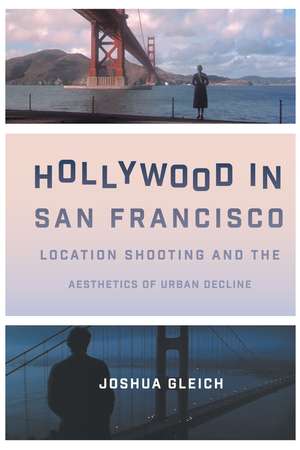Hollywood in San Francisco: Location Shooting and the Aesthetics of Urban Decline: Texas Film and Media Studies Series
Autor Joshua Gleichen Limba Engleză Hardback – 14 noi 2018
In this thirty-year history of feature filmmaking in San Francisco, Joshua Gleich tracks a sea change in Hollywood production practices, as location shooting overtook studio-based filming as the dominant production method by the early 1970s. He shows how this transformation intersected with a precipitous decline in public perceptions of the American city, to which filmmakers responded by developing a stark, realist aesthetic that suited America’s growing urban pessimism and superseded a fidelity to local realities. Analyzing major films set in San Francisco, ranging from Dark Passage and Vertigo to The Conversation, The Towering Inferno, and Bullitt, as well as the TV show The Streets of San Francisco, Gleich demonstrates that the city is a physical environment used to stage urban fantasies that reveal far more about Hollywood filmmaking and American culture than they do about San Francisco.
Din seria Texas Film and Media Studies Series
-
 Preț: 201.80 lei
Preț: 201.80 lei -
 Preț: 202.07 lei
Preț: 202.07 lei -
 Preț: 240.63 lei
Preț: 240.63 lei -
 Preț: 277.53 lei
Preț: 277.53 lei -
 Preț: 262.40 lei
Preț: 262.40 lei -
 Preț: 277.16 lei
Preț: 277.16 lei -
 Preț: 203.73 lei
Preț: 203.73 lei -
 Preț: 277.16 lei
Preț: 277.16 lei -
 Preț: 201.40 lei
Preț: 201.40 lei -
 Preț: 279.83 lei
Preț: 279.83 lei -
 Preț: 196.60 lei
Preț: 196.60 lei -
 Preț: 277.16 lei
Preț: 277.16 lei -
 Preț: 198.89 lei
Preț: 198.89 lei -
 Preț: 241.38 lei
Preț: 241.38 lei -
 Preț: 166.47 lei
Preț: 166.47 lei -
 Preț: 166.47 lei
Preț: 166.47 lei - 23%
 Preț: 501.82 lei
Preț: 501.82 lei -
 Preț: 277.16 lei
Preț: 277.16 lei -
 Preț: 240.63 lei
Preț: 240.63 lei -
 Preț: 203.34 lei
Preț: 203.34 lei -
 Preț: 203.73 lei
Preț: 203.73 lei -
 Preț: 288.31 lei
Preț: 288.31 lei
Preț: 615.45 lei
Preț vechi: 799.28 lei
-23% Nou
Puncte Express: 923
Preț estimativ în valută:
117.77€ • 125.93$ • 98.19£
117.77€ • 125.93$ • 98.19£
Carte tipărită la comandă
Livrare economică 17 aprilie-01 mai
Preluare comenzi: 021 569.72.76
Specificații
ISBN-13: 9781477316450
ISBN-10: 1477316450
Pagini: 360
Ilustrații: 66 b&w photos
Dimensiuni: 152 x 229 x 28 mm
Greutate: 0.45 kg
Editura: University of Texas Press
Colecția University of Texas Press
Seria Texas Film and Media Studies Series
ISBN-10: 1477316450
Pagini: 360
Ilustrații: 66 b&w photos
Dimensiuni: 152 x 229 x 28 mm
Greutate: 0.45 kg
Editura: University of Texas Press
Colecția University of Texas Press
Seria Texas Film and Media Studies Series
Notă biografică
Joshua Gleich is an assistant professor in the School of Theatre, Film, and Television at the University of Arizona. His work has appeared in Cinema Journal, New Review of Film and Television Studies, and The Velvet Light Trap.
Cuprins
- Acknowledgments
- Introduction
- Chapter 1. Postwar Location Shooting, the Semi-Documentary, and Dark Passage
- Chapter 2. The Cine-Tourist City: From Cinerama to The Lineup and Vertigo
- Chapter 3. “Sick Tales of a Healthy Land”: Blake Edwards in San Francisco
- Chapter 4. Countercultural Capital: Hollywood Chases the Summer of Love
- Chapter 5. The Manhattanization of San Francisco: Dirty Harry and The Streets of San Francisco
- Chapter 6. Hollywood North / Hollywood Resurgence: The Conversation and The Towering Inferno
- Conclusion: Hollywood’s San Francisco
- Appendix. Films Set and/or Shot in San Francisco between 1945 and 1975
- Bibliography
- Index
Recenzii
Hollywood in San Francisco is valuable for its wide-ranging historical scholarship on the golden age of location shooting in San Francisco.
This thoroughly researched book depicts a faithful account of the practice of decentralization of location shooting to the north of Los Angeles in the postwar era....We have come to know Joshua Gleich as a knowledgeable, prolific, and engaged commentator on film and television history, and on connecting various disciplines in urban and media studies, and this book is part of that universe... At a time when records and archives are under threat of simply being thrown away, an account this dense as Gleich’s book is more than timely.
Descriere
This pioneering study of postwar feature films set in San Francisco tracks the transformation of Hollywood filmmaking as location shooting became the dominant production method in an era of urban anxiety.
